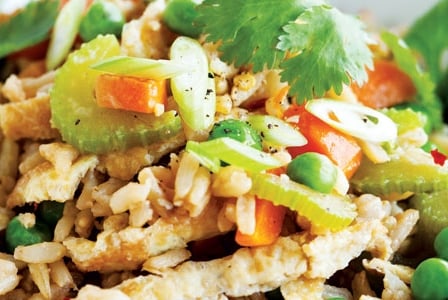
Rich in gustatory romance, Chinese cuisine has burst through borders to become celebrated the world over. When you’re in a time crunch or feeling too weary to cook, it’s tempting to call for Chinese takeaway.
Unfortunately, many Australian versions are little more than a greasy, sugary, overly salty and MSG-laden excuse for Chinese food that is far removed from the healthy dishes served up by traditional cooks.
Luckily, you can satisfy your cravings for speedy Chinese without wrecking your waistline by making your own. Many of the famed dishes surprisingly require minimal effort and time. To prove it, we sent five lost-in-translation Chinese dishes up the Yangtze and brought back healthier, more flavourful genuine renditions.
Recipes
- Egg Fried Rice
- Sweet and Sour Tofu
- Orange Chicken
- Wonton Soup
The Chinese pantry
Part of the secret to successful Chinese cooking is arming yourself with tried-and-true ingredients. Look for many of these items in the Asian section of supermarkets or, better yet, Asian supermarkets.
Bok choy
This member of the cabbage family, often used in soups and stir-fries, has white stalks and dark green leafy tops that are slightly bitter and abundant in vitamins C and K.
Rice wine
This is a salted cooking wine produced when glutinous rice starch ferments into sugars. Epicureans prefer shao hsing variety for its consistent good quality.
Peanut oil
Extracted by pressing shelled peanuts, peanut oil is often the oil of choice for Chinese cooks as it has a high smoke point ideal for stir-frying. If peanut allergies are an issue, grapeseed oil is neutral tasting and also has a high smoke point. Look for non-GMO options at your favourite health food store.
Hoisin sauce
This is a sweet and spicy sauce with jam-like consistency often made from soybeans, garlic, sesame seeds, chillies and spices. Use it to punch up stir-fry sauces.
White pepper
White pepper is a slightly milder version of the common black peppercorn that Chinese cooks favour for soups, marinades and sauces. For the best flavour, crack whole peppercorns just before adding to a recipe.
Rice vinegar
Made from glutinous rice, rice vinegar is less acidic and milder than regular vinegar, with a hint of sweetness. Sack the MSG
Monosodium glutamate, a flavour enhancer sprinkled into a wide variety of Chinese fast food, has already been linked to neurological problems. Now a new study suggests it may contribute to Buddha belly as well. Scientists reported in the American Journal of Clinical Nutrition that MSG intake was positively associated with weight gain in adult subjects, possibly by disrupting hypothalamus functioning. Just one more reason to make your own Chinese!
Wok star
When it comes to cooking methods in Asia, few are as sacrosanct as stir-frying. Proper stir-frying uses intense heat to sear proteins and cook vegetables quickly, helping them retain more nutrients, as well as their flavour, texture and striking hues.
Typically, stir-frying should be done in a wok, ideally cast iron and carbon steel, as stainless steel produces uneven heat. Look for one about 14 in (36 cm) wide with a depth of 4 in (10 cm) to prevent splattering and with a flat bottom to allow it to sit directly on a stovetop burner. You can also get good stir-fry results with a pan, but make sure to use one that has high sides to hold a lot of food.
Guilt-free Chinese
Use these tips to up the health ante of your Chinese cooking.
Veg out
Most fast-food Chinese is sorely lacking in the vegetable department. We tend to forget that traditional Chinese cooking places an emphasis on vegetables with smaller portions of meat as an accompaniment. When making your own recipes, make sure to pack them with plenty of vegies such as capsicum, Chinese greens and mushrooms.
Sodium shakedown
One item Chinese dishes often have in spades is salt. When shopping for items such as soy sauce, oyster sauce and stock, compare brands to find the ones containing the least salt.
Great grain
Instead of nutritionally light white rice, serve higher-fibre brown rice with your Chinese meals. A Harvard study reported eating two or more servings of nutrient-rich brown rice each week, as opposed to less than one serving a month, was associated with an 11 per cent reduced risk of developing type 2 diabetes.
Cooking light
Much of the Chinese food you find at buffets or delivery establishments is deep-fried. When cooking your own, embrace lower-fat preparation methods such as steaming and stir-frying.



